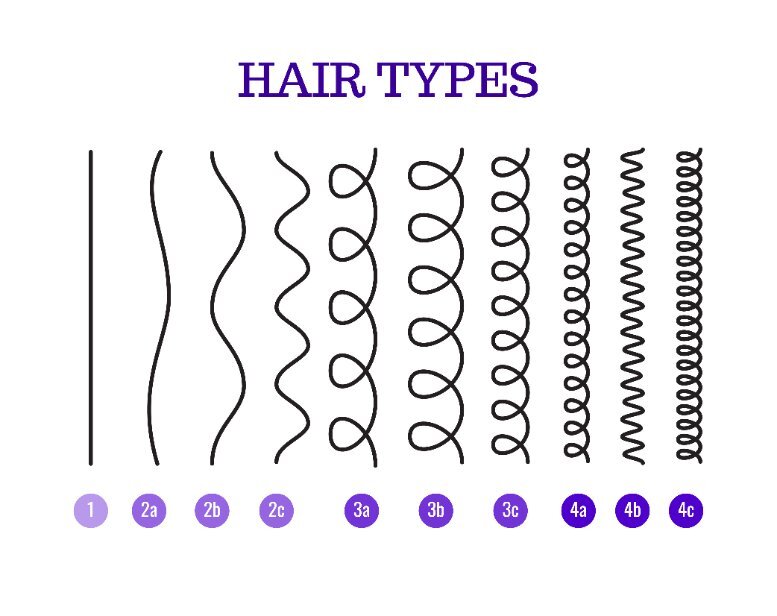What is your hair type?
Key Points
- Hair type, structure, and scalp moisture collectively define how your hair looks, feels, and responds to products and styling.
- Each of the four main hair types—straight, wavy, curly, and coily—has three distinct subcategories based on shape and texture.
- Understanding your unique hair and scalp profile is essential for creating a tailored, effective hair care routine.
What is your hair type?
Do you know what your hair type is? Of course, you know whether your hair is stick straight, super coily, or something in between. However, there are actually a few more things to consider when determining what makes your hair uniquely your own.
Below, we'll discuss hair type, hair structure, scalp moisture, and the different hair subcategories. Knowing these factors will better prepare you to establish the most effective hair care routine for your specific needs, ensuring that your hair is in the best shape possible!
Hair Type
The first factor to discuss is hair type, which most people are already familiar with. There are four different categories: straight, wavy, curly, and coily. These types refer to the appearance of a person's natural hair without heat styling.
Straight Hair:
Hair lays flat and dries without any bend or curl.
Known for sleekness and shininess.
Indicates straight hair type.
Wavy Hair:
Hair dries with a noticeable "S" shape, forming loose waves.
Balances between straight and curly, often versatile in styling.
Characterizes wavy hair type.
Curly Hair:
Hair dries into springy ringlets or tight spirals.
Voluminous and full of life.
Defines curly hair type.
Coily Hair:
Hair shows tightly coiled spirals or zig-zag patterns from the scalp.
Known for its density and texture.
Signifies coily hair type.
Interestingly, your hair type is determined by the shape of your hair follicles, which is influenced by genetics. The more oval or asymmetrical the shape of the hair follicle, the curlier the hair strand will be.
Of course, you can alter your natural hair with styling (such as with hot tools or chemical treatments). That said, even without styling, your hair type can naturally change throughout your life. Your hair's curl pattern may vary during times of hormonal fluctuation or when taking certain medications.
Hair Structure
The next factor in determining when assessing your hair is your hair structure. This typically affects how your hair holds certain styles and reacts to different styling products. There are three different hair structure categories:
Fine Hair: With fine hair, a strand of hair is thinner than a sewing thread. If you take a fine strand between your fingers, you won't feel anything. Finer hair can sometimes be more challenging to style since it is delicate and may not hold styles as easily as thick hair.
Medium: An individual strand of medium-structured hair will be similar in thickness to a sewing thread, and you can feel it between your fingers. Medium hair is typically fairly easy to style, as it can hold the style well.
Coarse: A strand of coarse hair is thicker than a sewing thread. When you take a strand of hair between your fingers, you'll feel a strong and thick strand. Coarse hair can hold a style, but it may be harder to manipulate since it's more resistant to change.
If you're unsure about your hair structure, you can use an actual piece of thread to make a side-by-side comparison. Take a strand of hair from your hairbrush and lay it against a different colored surface next to a sewing thread to see how it compares.
Knowing Your Hair Subcategory
Before discussing scalp moisture, it's important to discuss hair subcategories. Each of the four types of hair has three subcategories (grouped under A, B, or C). These groupings help pinpoint a person's hair's specific characteristics better.
Straight Hair Subcategories
Within straight hair, there are types 1A, 1B, and 1C, which are based on hair structure:
Type 1A: This type is fine and soft and generally easy to manage (although it may not hold some hairstyles super easily). Too much hair product can weigh down this fine hair.
Type 1B: Type 1B hair has a medium structure and is generally easy to style.
Type 1C: This hair type is coarser and has more volume than the other two subtypes.
Wavy Hair Subcategories
Type 2 hair is broken down further into categories 2A, 2B, and 2C, which are based on the wave pattern and thickness:
Type 2A: This type has gentle waves that are fine and easy to manage. Hair is straighter from the roots to the eye level but then has loose waves from eye level down.
Type 2B: Like type 2A, the waves of 2B start around eye level but have a more defined S-shape. Individual strands are also thicker than type 2A.
Type 2C: Type 2C strands are coarser and have well-defined S-shapes. The wave pattern starts closer to the root and continues to the ends.
Curly Hair Subcategories
Curly hair is broken into types 3A, 3B, and 3C, based on the tightness of the curls:
Type 3A: Type 3A has the loosest curls of the three sub-groupings – approximately the same circumference as the base of a taper candle. These curls tend to have some shine.
Type 3B: Type 3B ringlets are springy and defined and have the approximate circumference of the thickest part of a Sharpie. The curls start close to the root.
Type 3C: Type 3C curls are densely packed, tight corkscrews with a circumference around the size of a pencil. This type is quite voluminous and generally not as shiny compared to types 3A and 3B. It is also more prone to frizz.
Coily Hair Subcategories
Type 4 hair is broken down into types 4A, 4B, and 4C:
Type 4A: This type is defined by dense and springy S-pattern coils approximately the circumference of a chopstick.
Type 4B: Type 4B has densely packed coils that can bend at sharp angles.
Type 4C: Type 4C coils are similar to 4B coils but tighter and more delicate. This type is particularly prone to breakage and shrinkage.
Scalp Moisture
The final piece of the puzzle is scalp moisture. Healthy hair starts at the scalp, so knowing how to best care for your scalp is crucial. There are three categories of scalp moisture: dry, normal, and oily.
For those with normal scalp moisture, their hair will look the same a day after washing. They tend not to be prone to dandruff or excessive oil.
Those with dry scalps typically go three to four days (or longer) between washes and may notice some flakiness. They may also feel itchiness or irritation and benefit from a moisturizing and gentle shampoo and conditioner. Applying oils or other hydrating products to the hair can also be beneficial, as the hair strands aren't getting that nourishment from natural oils.
Finally, those with oily hair will need to wash their hair daily to combat greasy hair. This scalp moisture type may need to use an oil-control shampoo to prevent build-up.
References:
- Loussouarn G, El Rawadi C, Genain G. Diversity of hair growth profiles. Int J Dermatol. 2005;44 Suppl 1:6–9. doi:10.1111/j.1365-4632.2005.02800.x
- Swift JA, Bews B. The morphology and physiology of human hair. Clin Dermatol. 1985;3(4):13–20. doi:10.1016/0738-081X(85)90042-4
- Tobin DJ. Biochemistry of human hair—our current understanding. Clin Dermatol. 2005;23(4):319–326. doi:10.1016/j.clindermatol.2004.06.012
- Khumalo NP, Jessop S, Gumedze F, Ehrlich R. Hair care practices and the risk of scalp and hair disorders in African women. J Am Acad Dermatol. 2010;62(5):853–862. doi:10.1016/j.jaad.2009.07.025
- Messenger AG, Sinclair RD. Follicular miniaturization in androgenetic alopecia: clinicopathological correlations. Br J Dermatol. 2006;155(5):890–895. doi:10.1111/j.1365-2133.2006.07421.x
- van Neste D. Thickness, medullation, and growth rate of female scalp hair are subject to significant variation according to pigmentation and scalp location. Eur J Dermatol. 2004;14(1):28–32
- Roberts JL, James JH, Lacharité C. Hair and scalp disorders: a medical overview. Dermatol Clin. 2013;31(1):1–16. doi:10.1016/j.det.2012.08.003
- Rebora A. Dry scalp and seborrheic dermatitis: pathogenesis and therapeutic options. Clin Dermatol. 1997;15(5):567–573. doi:10.1016/S0738-081X(97)00065-3
- Zhang P, Wu X, Li L. Human hair follicle in aging and alopecia: A mini-review. Gerontology. 2021;67(6):581–591. doi:10.1159/000514193
- Lindelöf B, Forslind B, Hedblad MA, Kaveus U. Human hair form: Morphological and biochemical variations in different parts of the hair. Acta Derm Venereol. 1988;68(5):395–400.
Find the most effective hair growth products for you by taking the free hair assessment.





